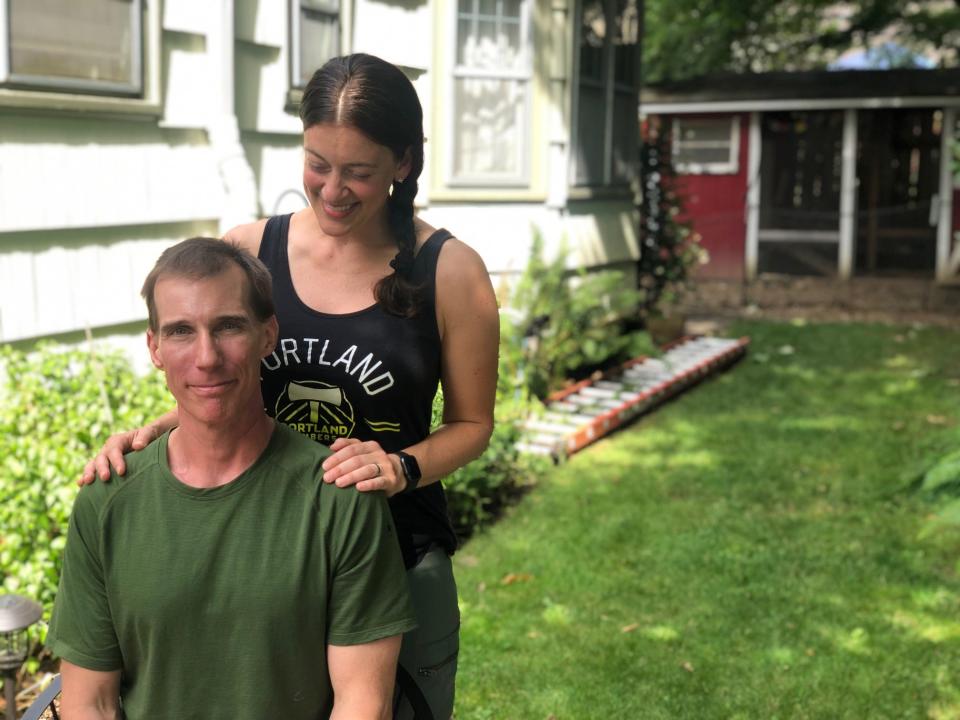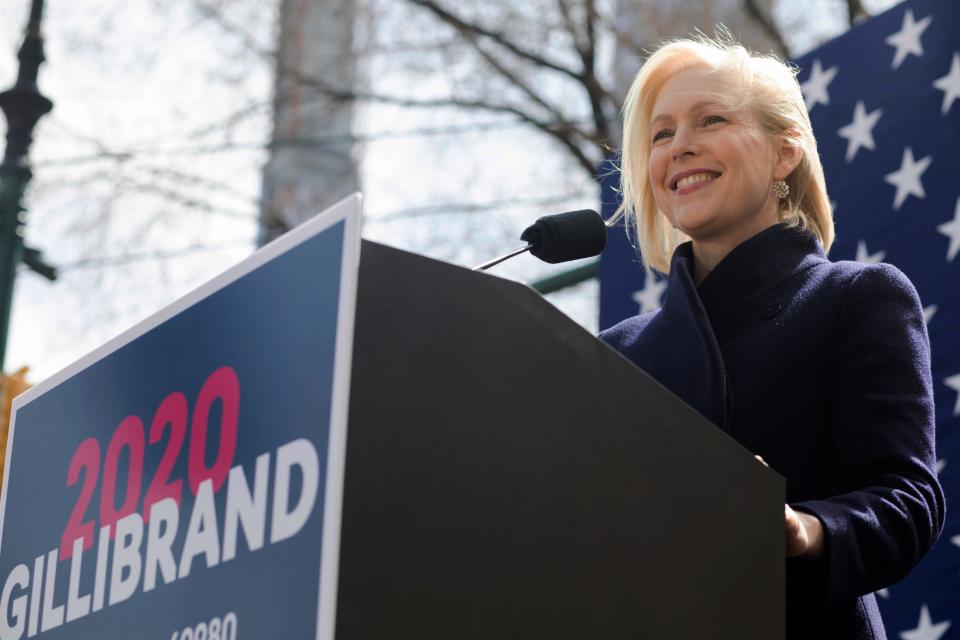Oregon could soon have nation's most progressive paid family leave law, will the US follow?
PORTLAND, Ore. – When her husband was diagnosed with throat cancer in March, Dacia Grayber panicked.
Her mind raced with questions: How would Matt Laas, her husband of eight years, respond to treatment? How would they tell their five kids?
What she didn’t worry about – naively, she says now – was taking time off to care for Laas. The husband and wife firefighters, who have 35 years of service between them, figured that careers built on public service and self-sacrifice had to come with some form of paid family medical leave, right?
Wrong.
Without paid time off, Laas was forced to use the vacation days he had saved up over 20 years. And when Graybar asked her human resources office what would happen if she used all her vacation days to care for her husband and then, say, broke her leg later in the year and needed to take more paid time off, she was told she wouldn't have the option.
“That was the beginning of the upside-down world we’ve been in ever since,” Grayber says. “It brings it into focus: if this is how difficult it is for us, two people with good jobs and good union benefits, how must this be for people who are living paycheck to paycheck, working at McDonald's or Walmart?”
Laas and Grayber’s story illustrates the plight of many Americans: People need time off to care for themselves or for sick loved ones, but because there’s no national paid family medical leave, workers are often forced to choose between caregiving or paying bills. According to the Pew Research Center, only 14% of U.S. workers are granted paid leave by their employers. While the federal Family Medical Leave Act offers job protection for workers who need to take time off, it doesn’t include paid leave.
But a measure poised to become law in Oregon this summer could soon create change for workers in the state. And advocates hope it will prompt a national push for paid family medical leave, too.
In August, Oregon Gov. Kate Brown is expected to sign into law HB 2005, which proponents are hailing as the nation’s most progressive paid family medical leave act. It includes 100% wage replacement for minimum wage workers for up to 12 weeks and the ability to define family on each individual’s terms. It will cover undocumented workers and offers paid leave to victims of domestic violence, harassment, stalking and sexual assault.
When the bill is signed, Oregon will join eight other states, plus the District of Columbia, in offering paid family medical leave. The Oregon measure would go into effect in 2023.

Advocates of workers' rights predict that in the coming months, paid family medical leave will become a national conversation, particularly with the 20-plus Democrats running to challenge President Donald Trump in 2020. Paid leave was already a big talking point for Hillary Clinton and Ivanka Trump, the president's daughter and White House adviser, in the 2016 election. And since then, women have seen more electoral success, lessening the gender divide in Congress and other legislative bodies in the U.S. Meanwhile, celebrities have taken up the cause, including Anne Hathaway, Maggie Gyllenhaal and Alexis Ohanian Sr., the co-founder of Reddit who is best known as the husband of tennis superstar Serena Williams.
Debra L. Ness, president of the National Partnership for Women & Families, an organization that works to better the everyday lives of families and women, said for decades, “it felt like every woman had to solve this on her own.” But as more women join the legislative ranks, the more “everyday struggles” are discussed on the national stage, Ness said.
Of course, it isn't only women who have money on the line.
When paid family medical leave comes up in conversation around dinner tables and water coolers, people’s minds often drift to one particular scenario: Mothers and babies. Statistics, however, show only 21% of paid family leave comes from mothers needing time with new children. The majority of family leave is taken for individual care or to provide for another loved one, like an aging parent.
Family leave: You may not realize this benefit doesn't kick in right away
More than 60% of workers have taken or are likely to take leave in the future, according to Pew. But many can’t afford to do it, especially if their household income is less than $30,000. Roughly half the nation's wage earners take home about $31,500 or less.
For those who do take off without pay, the price is steep. Families have reported going into debt, draining savings and going on public assistance to pay their bills, according to a 2017 study from the Urban Institute.
Paid family leave debate could influence 2020 race
Many of the 25 Democrats running for president have mentioned paid family medical leave and agree it’s crucial to the economic future of the U.S.
But no one has a plan as detailed as Sen. Kirsten Gillibrand, D-N.Y., who has spent years passionately advocating for paid family medical leave and has built her campaign around the issue. If elected, she has promised to enact the Family Bill of Rights within her first 100 days as president, which includes significant investments in paid family leave, maternal and child health, affordable child care and universal preschool.
In June, at MoveOn’s Big Ideas Forum in San Francisco, Democratic candidates had just five minutes to pitch “one big idea” that could change the United States. Gillibrand’s topic of choice? Paid family leave.
It was hardly her first time stumping for the issue. In 2013, Gillibrand spoke at the Center for American Progress on “the American opportunity agenda,” explaining that the face of the American workforce had changed. Gone were the days where mom stayed home to cook and clean while dad paid the bills with a full-time gig. In the “Mad Men” era, she said, most women stayed home while men worked. Now about half of households have two working parents, and 40% of families with children under 18 rely on women alone to pay the bills.
“My goal in 2013 was to raise the issue so it became a national issue, so it would be debated in the last (2016) presidential campaign,” Gillibrand said. “And it was. We had Democrats and Republicans with their own paid leave plans – now the Republican ones were obviously terrible, but at least they felt it was necessary to talk about. Even President Trump put it in his State of the Union, as well as trying to push his very inadequate plan.
“I think people are desperate for national paid leave … it’s an idea whose time has come.”
For 2020, she sees potential for a movement that follows the path Barack Obama laid with healthcare in his 2008 presidential bid. Twelve years ago, when Obama emerged as the Democratic candidate, healthcare wasn’t considered an American right. But when Obama and other politicians started talking about affordable cancer treatment and how a tax bracket should never determine if you can get life-saving drugs like insulin, the national mindset, and expectation, changed. Now polls routinely show that healthcare is voters’ top priority.
Despite growing support for paid family medical leave, Gillibrand has so far struggled to register with voters. An NBC/Wall Street Journal poll from July 11 had her with less than 1% support.
More: Gillibrand formally joins crowded field of Democratic presidential candidates
Elizabeth Warren and Kamala Harris, two of the six women running for president, have also introduced national paid leave policies. On July 26, South Bend, Indiana, Mayor Pete Buttigieg announced a detailed plan that would expand workers' rights, including national paid family leave. Washington Gov. Jay Inslee, another Democratic presidential candidate, told USA TODAY that everyone else will be "chasing me" on the issue, because "I've got the best one in the country," pointing to Washington's progressive paid family leave act that passed in 2017 and goes into effect in 2020.
All workers would benefit from paid family leave
For many families, paid family medical leave could make a significant difference when it comes to household wealth.
Statistically, people who leave the workforce to become caregivers lose more than $300,000 in wages over the course of their lifetimes, according to a MetLife Mature Market Institute Study. That number is even higher for women, who are typically saddled with caregiving duties even as they make up more and more of the U.S. workforce.
The lack of paid family leave is “a constant downward pull, particularly for women and particularly for low-income women,” Gillibrand said. “We call that ‘the sticky floor.’ Every life event, they have to start over at the bottom rung, so they never get their career off the floor.”
But with more women working, especially in government, Gillibrand and other paid leave activists are confident the national attitude can change. President Donald Trump’s election in 2016 saw an uptick in women's activism, including the Women's March, and historical numbers of women being elected to Congress in the 2018 midterms.

“Women are really expecting candidates to step and up and talk about this,” said Ness, of the National Partnership for Women & Families. “They’re going to need candidates to talk about it, and (candidates) shouldn’t be waiting for debate moderators or reporters to challenge them about it – voters are waiting to see who’s going to talk about the everyday issues that impact them.”
Lili Hoag is the political director of Family Forward Oregon, an organization dedicated to pushing for policies that help Oregon families find economic security. She led the Time to Care Coalition, which helped pass Oregon’s paid family medical leave bill. When she speaks to groups about paid family medical leave and its importance, she starts off by saying, “Raise your hand if somebody gave birth to you.” When every hand in the room goes up, she smiles and explains, “OK, then this is something that directly impacts you.”
Already, there’s support across party lines: According to the National Partnership for Women & Families, 94% of Democrats, 83% of independents and 74% of Republicans support paid family leave. In Oregon, numerous Republicans in both the House and Senate crossed the aisle to vote yes on the bill.
A law that recognizes the family you choose
When Yee Won Chong moved from Malaysia to the United States 26 years ago, he said goodbye to the only family he’d ever known. As an immigrant in an unfamiliar country, he was forced to build new relationships, and create what he calls “a chosen family.”
When he got diagnosed with breast cancer in 2016, that chosen family “showed up for me,” he said. Their support and care was crucial as Chong recovered from chemo, a lumpectomy, a double mastectomy, radiation and hysterectomy.
“In my case, I have nowhere near a ‘nuclear family,'” said Chong, who identifies as queer. “And my situation is similar to a lot of LGBTQI people. … I am optimistic this can become a national issue. A lot of people, including heterosexual people, are not in this very narrow definition of family.”
Chong, who has been cancer free for two years and continues to be closely monitored by doctors, has since become an advocate for paid family leave, as someone who has been cared for and who has taken care of others. Eight years ago, when Chong’s parents fell ill in Malaysia, he was able to take paid family leave to visit them, the benefit of working for a progressive employer. He never had to explain or justify his request for time off – and everyone should have that right, he said.

Under the proposed law in Oregon, other workers could soon enjoy the same flexibility when requesting paid leave. The state will join New Jersey and Connecticut in defining a family member as a blood relative or anyone the employee has a close association with that's "the equivalent of a family relationship."
It's not the 1950s anymore, said Hoag of Family Forward. When Oregon lobbyists went to work on paid family leave, they went in with the mindset that "no one should be excluded."
"No one should have to win the boss lottery to take time because they got cancer or had a baby," Hoag said.
Gillibrand, too, is optimistic that language around paid family leave can get more inclusive as more states pass their own laws.
“That’s one of the reasons why it’s great that states are trying to pass paid leave plans too; every success builds on the next," she said. "If we can see what the Oregon model looks like and how it works, that’ll be something to build off of when we do a national plan.”
She points to the continued fight for gay rights in the U.S. as an example: As some states passed gay marriage, Gillibrand was simultaneously working to repeal the military’s "don’t ask, don’t tell" policy. Those two causes, she said, eventually culminated in the Supreme Court’s landmark 2015 decision that legalized same-sex marriage across the country.
Going back to work with no days off
As for Laas, the 49-year-old firefighter is eager to get back to work. Tired of a liquid-only diet and temporarily ruined taste buds (everything tastes bad, he said, even Dairy Queen sundaes), he admits he’s not the greatest patient. He’s bored, especially now that the Women’s World Cup is over, though it’s probably a good thing for his extremely sensitive vocal chords that he’s not yelling at the TV anymore.
After finishing up his radiation treatment July 1, Laas expects to return to desk duty in the next two months. Ideally, he’ll be back in the field by November.
The memory of cancer won’t fade anytime soon. He has two constant reminders of what his family went through: The long scar that twists around the side of his left neck, plus the sobering reality that he’s already out of paid time off for 2019.
This article originally appeared on USA TODAY: Paid time off for medical leave could be the next health care battle

